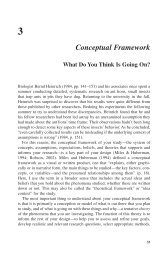Mixed Integer Linear Programming in Process Scheduling: Modeling ...
Mixed Integer Linear Programming in Process Scheduling: Modeling ...
Mixed Integer Linear Programming in Process Scheduling: Modeling ...
Create successful ePaper yourself
Turn your PDF publications into a flip-book with our unique Google optimized e-Paper software.
140 FLOUDAS AND LIN<br />
Lee, Park, and Lee (2001), Burkard, Fortuna, and Hurkens (2002) and Wang and Guignard<br />
(2002).<br />
Zhang (1995) and Zhang and Sargent (1996, 1998) developed the first cont<strong>in</strong>uoustime<br />
models for the schedul<strong>in</strong>g of general network-represented processes. Their formulations<br />
employ either the STN or the RTN representation and can handle mixed production<br />
facilities <strong>in</strong>volv<strong>in</strong>g both batch and cont<strong>in</strong>uous processes. One of the key variables <strong>in</strong><br />
their formulations concerns the tim<strong>in</strong>gs of events, Tk. This set of cont<strong>in</strong>uous variables<br />
are required to be monotonically <strong>in</strong>creas<strong>in</strong>g.<br />
0 = T1 < T2 < ···< TK ≤ H, (6)<br />
where H is the time Horizon.<br />
Then, based on the STN framework, two sets of b<strong>in</strong>ary variables can be def<strong>in</strong>ed<br />
to associate the tasks to the events. Wijk determ<strong>in</strong>es whether or not task (i) starts at Tk<br />
<strong>in</strong> unit ( j) and Xijkk ′ is activated if task (i) starts at Tk <strong>in</strong> unit ( j) and completes at Tk ′.<br />
With these variables, the allocation constra<strong>in</strong>ts can be written as follows to ensure that<br />
if a task starts <strong>in</strong> a unit at one event time, it f<strong>in</strong>ishes at exactly one later event time and<br />
that at each event time a unit can be occupied by at most one task.<br />
Wijk = �<br />
k ′ Xijkk<br />
≥k<br />
′, ∀i ∈ I, j ∈ Ji, k ∈ K, (7)<br />
� �<br />
Xijkk ′′ ≤ 1, ∀ j ∈ J, k′ ∈ K. (8)<br />
i∈I j<br />
k≤k ′ ≤k ′′<br />
Capacity constra<strong>in</strong>ts and mass balances are expressed <strong>in</strong> similar forms as those <strong>in</strong><br />
the discrete-time models.<br />
WijkV M<strong>in</strong><br />
ij<br />
≤ Bijk ≤ WijkV Max<br />
ij , ∀i ∈ I, j ∈ Ji, k ∈ K, (9)<br />
Ssk = Ss,k−1 + �<br />
i∈I p<br />
ρ<br />
s<br />
p<br />
� �<br />
is<br />
j∈Ji k ′ Xijk<br />
≤k<br />
′ �<br />
k Bijk ′ −<br />
i∈I c ρ<br />
s<br />
c �<br />
is WijkBijk, ∀s ∈ S, k ∈ K.<br />
j∈Ji<br />
(10)<br />
The duration of a task, represented by variable tijk,isdeterm<strong>in</strong>ed by the follow<strong>in</strong>g tim<strong>in</strong>g<br />
constra<strong>in</strong>t:<br />
tijk = �<br />
Xijkk ′(Tk ′ − Tk), ∀i ∈ I, j ∈ Ji, k ∈ K. (11)<br />
k ′ >k<br />
Note that Constra<strong>in</strong>ts (10) and (11) <strong>in</strong>volve bil<strong>in</strong>ear products of b<strong>in</strong>ary and cont<strong>in</strong>uous<br />
variables. Exact l<strong>in</strong>earization techniques (Glover, 1975; Floudas, 1995) can be applied<br />
to transform them <strong>in</strong>to l<strong>in</strong>ear forms at the cost of <strong>in</strong>troduc<strong>in</strong>g additional variables and<br />
constra<strong>in</strong>ts.<br />
Mockus and Reklaitis (1999a) proposed an alternative def<strong>in</strong>ition of the task-event<br />
assignment variables. In their cont<strong>in</strong>uous-time formulations, which is called<br />
Non-Uniform Discrete-Time Model (NUDTM), two sets of b<strong>in</strong>ary variables, W S<br />
ijk and
















